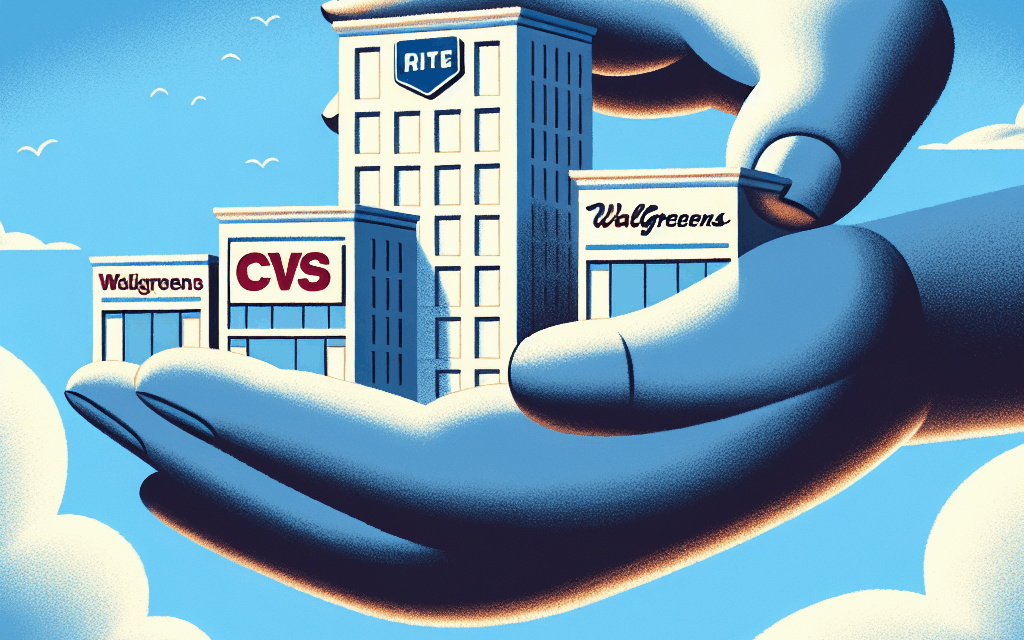Rite Aid Offloads Over 1,000 Stores to CVS, Walgreens, and More
The retail pharmacy landscape in the United States has undergone significant changes in recent years, with Rite Aid’s recent decision to offload over 1,000 stores to major competitors like CVS and Walgreens marking a pivotal moment in the industry. This article delves into the reasons behind this strategic move, the implications for the pharmacy sector, and what it means for consumers and employees alike. We will explore the financial health of Rite Aid, the competitive landscape of the pharmacy market, the impact on local communities, and the future of pharmacy retail in a rapidly evolving healthcare environment.
The Financial Struggles of Rite Aid
Rite Aid has faced a series of financial challenges over the past decade, leading to its decision to divest a significant portion of its store portfolio. Understanding these struggles is crucial to grasping the rationale behind the store closures and sales.
- Declining Sales: Rite Aid has experienced a consistent decline in sales, with reports indicating a drop in revenue from $8.1 billion in 2015 to approximately $5.5 billion in 2022. This decline can be attributed to increased competition from larger chains and the rise of online pharmacy services.
- Debt Burden: The company has been burdened with substantial debt, which peaked at over $3 billion. This financial strain has limited its ability to invest in store renovations, technology upgrades, and marketing initiatives.
- COVID-19 Impact: The pandemic exacerbated existing issues, as foot traffic in stores decreased and many consumers turned to online shopping for their pharmaceutical needs. Rite Aid’s inability to pivot quickly to e-commerce further hampered its recovery.
- Market Position: Rite Aid’s market share has dwindled in comparison to giants like CVS and Walgreens, which have expanded their services and locations. This has made it increasingly difficult for Rite Aid to compete effectively.
- Strategic Review: In light of these challenges, Rite Aid’s management initiated a strategic review, ultimately leading to the decision to offload over 1,000 stores to stabilize the company’s finances and focus on core operations.
These financial struggles have not only impacted Rite Aid’s bottom line but have also affected its employees and customers. The decision to sell stores was not made lightly, as it involved weighing the potential benefits against the risks of losing brand identity and customer loyalty.
The Competitive Landscape of Pharmacy Retail
The pharmacy retail sector is characterized by intense competition, with several key players vying for market share. Understanding this competitive landscape is essential to appreciate the implications of Rite Aid’s store divestitures.
- Market Leaders: CVS and Walgreens dominate the pharmacy market, with CVS holding approximately 24% of the market share and Walgreens around 20%. Their extensive networks and diversified services give them a significant advantage over smaller chains like Rite Aid.
- Online Pharmacies: The rise of online pharmacies, such as Amazon Pharmacy and PillPack, has disrupted traditional retail models. Consumers increasingly prefer the convenience of home delivery, forcing brick-and-mortar stores to adapt.
- Healthcare Integration: Major players are integrating healthcare services into their offerings. For instance, CVS has expanded its MinuteClinic services, while Walgreens has partnered with healthcare providers to offer in-store clinics, enhancing customer engagement.
- Price Competition: Price wars are common in the pharmacy sector, with retailers competing on prescription drug prices and over-the-counter products. This has put additional pressure on Rite Aid, which has struggled to match the pricing strategies of its larger competitors.
- Regulatory Environment: The pharmacy industry is heavily regulated, with changes in healthcare policies impacting how pharmacies operate. Rite Aid’s ability to navigate these regulations has been challenged, further complicating its competitive position.
As Rite Aid offloads its stores, it is essential to consider how these competitive dynamics will shape the future of pharmacy retail. The consolidation of stores may lead to a more concentrated market, with fewer players dominating the landscape.
Impact on Local Communities
The sale of over 1,000 Rite Aid stores has significant implications for local communities, particularly in areas where Rite Aid has been a longstanding presence. Understanding these impacts is crucial for assessing the broader consequences of the divestiture.
- Job Losses: The closure of stores often results in job losses for employees. Rite Aid’s decision to sell stores may lead to layoffs, affecting thousands of workers who rely on these jobs for their livelihoods.
- Access to Healthcare: In many communities, Rite Aid serves as a primary source of healthcare services, including prescription medications and immunizations. The loss of these stores may limit access to essential healthcare services, particularly in underserved areas.
- Economic Impact: Store closures can have a ripple effect on local economies. Businesses that rely on foot traffic from Rite Aid customers may experience declines in sales, leading to further job losses and economic downturns.
- Community Engagement: Rite Aid has historically engaged with local communities through health initiatives and sponsorships. The divestiture may result in a loss of community support and engagement, impacting local health outcomes.
- Transition to Competitors: While some communities may benefit from the transition to CVS or Walgreens, others may face challenges if these competitors do not prioritize the same level of service or community involvement as Rite Aid.
The impact on local communities underscores the importance of considering the human element in corporate decisions. As Rite Aid navigates its financial challenges, it must also be mindful of the communities it serves and the potential consequences of its actions.
Consumer Reactions and Adaptations
As Rite Aid offloads its stores, consumer reactions and adaptations will play a crucial role in shaping the future of pharmacy retail. Understanding how consumers respond to these changes provides valuable insights into the evolving landscape.
- Brand Loyalty: Many consumers have developed loyalty to Rite Aid over the years. The sale of stores may lead to feelings of uncertainty and frustration among customers who have relied on Rite Aid for their healthcare needs.
- Shifts to Competitors: Consumers may shift their loyalty to CVS or Walgreens, particularly if these competitors offer better services, pricing, or convenience. This transition may be influenced by factors such as location, product availability, and customer service.
- Online Shopping Trends: The pandemic has accelerated the trend toward online shopping, with many consumers now accustomed to ordering prescriptions online. Rite Aid’s inability to compete effectively in this space may lead to further customer attrition.
- Health and Wellness Focus: Consumers are increasingly prioritizing health and wellness, seeking pharmacies that offer comprehensive services beyond just filling prescriptions. The ability of competitors to meet these demands will influence consumer choices.
- Feedback and Engagement: Consumers are more vocal than ever about their experiences with pharmacies. Rite Aid’s decision to divest stores may prompt customers to share their feedback, influencing how competitors approach customer service and engagement.
As consumers adapt to the changing pharmacy landscape, their preferences and behaviors will shape the strategies of remaining players in the market. Understanding these dynamics is essential for Rite Aid and its competitors as they navigate this transition.
The Future of Pharmacy Retail
The offloading of over 1,000 Rite Aid stores signals a significant shift in the pharmacy retail landscape. As we look to the future, several trends and developments are likely to shape the industry.
- Consolidation Trends: The trend of consolidation in the pharmacy sector is expected to continue, with larger players acquiring smaller chains to expand their market presence. This may lead to fewer choices for consumers but could also result in improved services and efficiencies.
- Technological Advancements: The integration of technology into pharmacy operations will be crucial for remaining competitive. Pharmacies that invest in telehealth services, online ordering, and digital health tools are likely to thrive in the evolving landscape.
- Focus on Patient-Centric Care: The future of pharmacy retail will likely emphasize patient-centric care, with pharmacies offering personalized services, health screenings, and wellness programs to meet the needs of consumers.
- Regulatory Changes: Ongoing changes in healthcare regulations will impact how pharmacies operate. Staying abreast of these changes will be essential for pharmacies to remain compliant and competitive.
- Community Engagement: As pharmacies navigate the challenges of consolidation, those that prioritize community engagement and support will likely build stronger relationships with consumers, fostering loyalty and trust.
The future of pharmacy retail is poised for transformation, driven by consumer preferences, technological advancements, and competitive dynamics. Rite Aid’s decision to offload stores is just one chapter in this ongoing evolution.
Conclusion
The decision by Rite Aid to offload over 1,000 stores to CVS, Walgreens, and other competitors marks a significant turning point in the pharmacy retail landscape. This move is rooted in the company’s financial struggles, the competitive dynamics of the market, and the impact on local communities and consumers. As Rite Aid navigates this transition, it must balance its financial recovery with the needs of its employees and customers.
Looking ahead, the pharmacy retail sector is likely to continue evolving, with trends such as consolidation, technological advancements, and a focus on patient-centric care shaping the future. Understanding these dynamics will be essential for all stakeholders involved, from corporate leaders to consumers seeking reliable healthcare services.
In summary, Rite Aid’s offloading of stores is not just a corporate strategy; it is a reflection of broader trends in the healthcare landscape. As the industry adapts to changing consumer preferences and competitive pressures, the implications of these changes will resonate throughout communities and the healthcare system as a whole.





